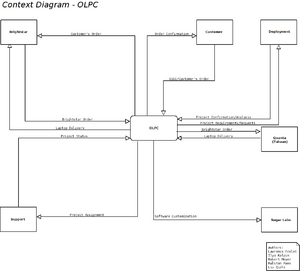Information Systems Analysis and Design Project
Team
College of Business, San Francisco State University
Professor: Dr. Sameer Verma, Ph.D. Information Systems Department
MBA Students:
Lawrence Frelot
Ilya Kalpin
Qizhi Liu
Robert Meyer
Ralston Paes
Introduction
This semester our team had the distinct privilege to work on a special project pertaining to OLPC (One Laptop Per Child), a non-profit association wholeheartedly engaged in a humanitarian effort to revolutionize the way the world’s poorest children learn, share, create, and collaborate. OLPC’s mission is “to provide educational opportunities for the world’s poorest children by providing each child with a rugged, low-cost, low-power, connected laptop with content and software designed for collaborative, joyful, self-empowered learning. To accomplish this mission, OLPC developed the ‘XO’ laptop, a low-cost and innovate computer.
Now that we have a general overview of OLPC, let’s examine the specifics of our project. We were informed that OLPC is dealing with an information flow problem. The purpose of this project is to harness and apply our knowledge to diagnose and analyze ways in which OLPC’s information systems could be improved. This documentation includes the following deliverables: a mind map, context diagrams, use cases, a data flow diagram, and an Entity Relationship diagram.
Maps and Diagrams
The mind map encapsulates the Support, Deployment, and Contribution areas. For the context diagrams, we built one at a project-wide level and one at the Contributor Program level. Note that the use cases, data flow diagrams, and Entity-Relationship (ER) diagram is for the Contributor Program only. These diagrams may help as a blueprint for further work. They may be seen ideally as a foundation for designing more efficient information systems. Many technologies could certainly evolve from these documents. In particular, a database and user-friendly forms for the Contributor Program could be constructed. Please note that these deliverables were created using information gathered from the following sources: phone conferences and face-to-face interviews with OLPC personnel, secondary research, and Dr. Sameer Verma’s lectures.
Mind Map
The FreeMind diagram (
Source file:File:SFSU ISAD mindmap.mm) was used to conceptualize the OLPC organization’s processes that were to be analyzed during the project. These processes included the Contributor Program, Support, and Deployment. With the diagram, the goals were to understand the roles of each group within the organization, their relationships to one another, and to discern areas for improvement.
The following will be posted shortly.
Context - OLPC level
Context diagrams are high-level systems engineering diagrams that depict all of the entities and users that may interact with a system. These diagrams also show the inputs and outputs of information that entities send to and receive from the systems, and where that information is stored. In a context diagram, entities are represented by a square, the system is represented by a rounded rectangle, and arrows represent data flows.
Entities
- Bright Star: Provider of distribution services for the OLPC organization.
- Customers: Individual customers who purchase laptops for personal use via programs such as G1G1. Also includes organizations that participate in contributor projects.
- Deployment: Support group handling mass distribution to institutional customers.
- Quanta: Manufactures XO laptops and installs software made by Sugar Labs.
- Sugar Labs: Developer of XO software (user interface).
- Support: OLPC specialists who provide support to ongoing projects. Support includes the Support Gang, Freelancers, Specialists who edit the wiki, and Specialists who work with deployment.
- OLPC: U.S. non-profit organization setup to oversee the creation of an affordable educational device for use in the developing world, with a mission to provide an XO to the poorest children using different types of contribution and deployment programs.
Data Flow
- The data that the Customer inputs into OLPC is a customer order or a proposal, which is then reviewed by OLPC specialists (Support Group). The data flowing out of OLPC to the Customer is a confirmation of the order or results of the review.
- The data flowing from OLPC to Support is the project data that the Support Gang reviews. The data that is outputted from Support and into OLPC is a direct result (approval/denial/modification needed) of the project proposal review.
- The data flowing from OLPC to Deployment is project data, which is ready to be deployed. The data flowing from Deployment to the OLPC is the deployment’s status and confirmation of delivery.
- The data flowing from OLPC to Quanta is the order received by Bright Star for shipment, which may include the quantity of XOs to be manufactured. The data flowing from Quanta to OLPC represents confirmation of order fulfillment.
- The data flowing from OLPC to Bright Star is the customer order. The data flowing from Bright Star to OLPC is confirmation of the Bright Star order and the fulfillment status.
- The data flowing from OLPC to Sugar Labs is a software request. The data flowing from Sugar Labs to OLPC is the request’s status.
